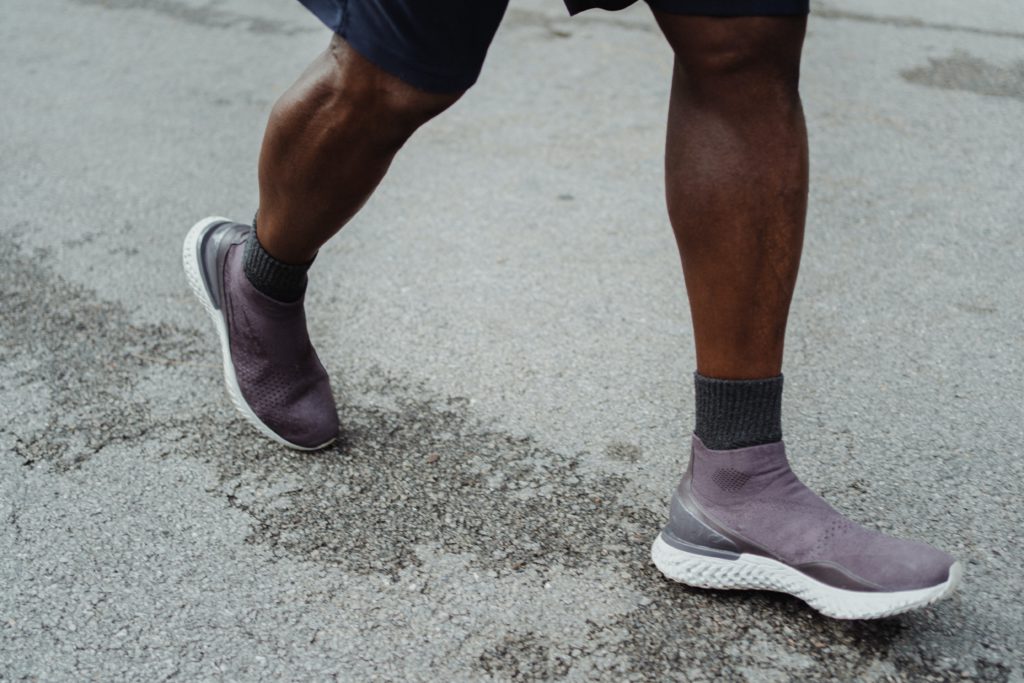
INTRO
What is a step challenge?

Taking steps, a.k.a. walking, involves the coordination of multiple muscle groups in the legs, hips, and feet. It requires balance, coordination, and control to maintain your body’s stability as you move forward and is important for mobility and independence.
The goal of a step challenge is to encourage people to become more physically active by setting weekly step targets and then tracking progress.
Starting a step challenge is a fun and motivating way to stay active and promote healthy habits. You can start your own step challenge or join a friend’s and keep each other motivated and accountable to reach your individual goals.
Benefits of Walking
Walking or taking steps can have a number of health benefits. Some of the benefits of taking steps include:
Improved balance and coordination
Walking can help to improve your balance and coordination, especially as you get older.
Reducing the risk of chronic conditions
Walking regularly can help to reduce the risk of developing chronic conditions such as diabetes, heart disease, and certain types of cancer.

Optimizing Your Steps

There are several important elements to consider while walking to reduce your risk of injury, including…
Balance. Maintaining balance is essential when taking steps, and can be accomplished by coordinating the movements of your legs, hips, and trunk to keep your body upright and stable as you walk.
Coordination. Walking requires coordination between your upper and lower body, as well as between the left and right sides of your body. This involves coordinating the movements of your arms and legs as you take steps.
Control. Walking requires control over your movements, including the force and timing of your steps. This helps to ensure that you move smoothly and efficiently as you walk.
Posture. Good posture is important when taking steps. Keep your head and shoulders aligned over your hips, and maintain a natural curvature in your spine.
Stride. The length and width of your stride can affect your efficiency and comfort when walking. A longer stride may be more efficient, but may also be more tiring. A shorter stride may be less efficient, but may also be less tiring.
Foot placement. Proper foot placement is important for balance and stability when taking steps. Place your feet flat on the ground and align them with your body as you walk.

Mix up Your Walking Style
There are several different ways that you can practice taking steps to improve your walking technique and performance.
Practice walking on different surfaces
Walking on different surfaces, such as grass, gravel, or sand, can help to improve your balance and coordination. Walking on an uneven surface, such as a balance beam or a line on the ground, can also help.
Add weights
Walking with weights, such as wrist weights or ankle weights, can help to improve your strength and endurance. Walk with heavy groceries if you’re on-the-go!
Practice walking with your eyes closed
Walking with your eyes closed can help to improve your balance and coordination by forcing you to rely on your other senses.
Walk with a partner
Walking with a partner can help to motivate you and provide feedback on your technique.
Practice walking backwards
Backwards walking improves coordination and balance, and also helps to strengthen different leg muscles important for knee strength.
Practice walking with purpose
Setting a goal or purpose for your walk, such as walking to a specific destination or tracking your distance, can help to motivate you to practice your steps.
How to Start a Step Challenge
1
Start small
Gradually increase the number of steps you take each day.
2
Set a goal
Set a goal for the number of steps you want to take each day and track your progress using a pedometer or a fitness tracker. Try aiming for 7000-10,000 steps each day for optimal health.
3
Be consistent
Incorporate walking into your daily routine by taking a walk after meals, during breaks at work, or instead of driving short distances. And take the stairs instead of the elevator or escalator whenever possible.
4
Walk with friends
Start or join a MasterHealth step challenge to stay motivated and accountable.
5
Add diversity
Walk in different locations to keep things interesting and to explore your community. Try a variety of walking workouts, such as power walking or interval training, to mix things up and keep your body challenged.
6
Be patient
Remember, it can take time to build a habit. Be patient with yourself and focus on making small, consistent changes over time.
Stepping Past Setbacks

Here are a few suggestions for overcoming common setbacks when trying to establish and stick to your step challenge:
Set realistic goals. It’s important to start with a goal that’s achievable, so that you don’t become discouraged. As you become more comfortable with stepping, you can gradually increase your goal.
Track your progress. Keep track of how many steps you take each day and try to beat your previous day’s total. This can help you stay motivated and see your progress over time.
Find a walking buddy. It can be helpful to have friends, co-workers, or family members to walk with or join your step challenge. This can help keep you accountable and make the activity more enjoyable.
Change up your routine. If you’re finding it difficult to fit more steps into your daily routine, try to find new ways to incorporate it. For example, take the stairs instead of the elevator, or park your car farther away from your destination.
Don’t get discouraged. It’s normal to have setbacks and have days when you don’t reach your goal. Don’t get discouraged and just try to get back on track the next day. Every step counts!

Step Things Up!
There are a variety of resources available to help you build and stick to your step habit. Here are a few examples:
Pedometers and step counters. These devices, which can be worn on your wrist or carried in your pocket, track the number of steps you take throughout the day and can help you stay motivated to reach your step goal.
Smartphones. Many smartphones have built-in pedometers or step-tracking apps that can help you track your progress and reach your goals.
Fitness trackers. Fitness trackers are wearable devices that track a variety of health metrics, including steps taken, distance traveled, and calories burned.
Social media. Many people find it helpful to connect with others who are working towards similar goals on social media. Invite your friends to join your MasterHealth challenge and cheer each other on as you reach your goals!
In-person support. Consider joining a walking group or finding a walking buddy to help you stay motivated and on track with your stepping habit.
Start a group steps challenge today!
Your clients & community will thank you.
FAQ's
The number of steps in a mile when walking can vary depending on stride length, height, and walking speed. However, on average, there are approximately 2,000 to 2,500 steps in a mile when walking.
If you have a longer stride length or are walking at a faster pace, you may take fewer steps to cover a mile. Similarly, if you have a shorter stride length or are walking at a slower pace, you may take more steps to cover the same distance.
If you want to calculate the number of steps you take per mile more precisely, you can measure your stride length by walking a set distance and counting the number of steps it takes you. Then, you can divide the length of a mile (5,280 feet) by your stride length to get an estimate of the number of steps you would take to walk a mile.
The number of calories you burn walking 10,000 steps will depend on a number of factors, including your weight, age, sex, and walking pace. On average, however, it’s estimated that a person can burn between 300 and 500 calories by walking 10,000 steps, which is roughly equal to walking 5 miles.
The number of calories burned is generally estimated to be about 0.04 to 0.05 calories per step, depending on your weight and the pace that you walk. So, if you weigh around 150 pounds and walk at a moderate pace, you may burn around 400 to 450 calories by walking 10,000 steps.
Keep in mind that walking 10,000 steps is a good goal for general health and fitness, but the number of steps required to burn a significant number of calories and achieve weight loss will vary depending on your individual circumstances.
The number of steps in a mile when walking can vary depending on stride length, height, and walking speed. However, on average, there are approximately 2,000 to 2,500 steps in a mile when walking.
If you have a longer stride length or are walking at a faster pace, you may take fewer steps to cover a mile. Similarly, if you have a shorter stride length or are walking at a slower pace, you may take more steps to cover the same distance.
If you want to calculate the number of steps you take per mile more precisely, you can measure your stride length by walking a set distance and counting the number of steps it takes you. Then, you can divide the length of a mile (5,280 feet) by your stride length to get an estimate of the number of steps you would take to walk a mile.
Hip pain when walking can be caused by several factors. Here are a few possible reasons:
- Osteoarthritis. This is a common form of arthritis that occurs when the protective cartilage on the ends of bones wears down over time. This can cause pain and stiffness in the hip joint, especially when walking.
- Bursitis. Bursae are small sacs of fluid that cushion the joints. When these sacs become inflamed, it can cause pain and tenderness in the hip joint. This is called bursitis and is often caused by repetitive motions like walking or running.
- Tendinitis. Tendons connect muscles to bones. When these tendons become inflamed, it can cause pain and discomfort. This is called tendinitis, and it can be caused by overuse or repetitive motions.
- Hip impingement. This is a condition where the bones of the hip joint rub against each other, causing pain and discomfort. It is often caused by a structural abnormality in the hip joint.
- Fractures. A fracture or break in the hip bone can cause severe pain and difficulty walking.
If you’re experiencing any pain while walking, it’s important to see a doctor to determine the underlying cause. They may recommend imaging tests like X-rays or an MRI to help diagnose the problem. Treatment will depend on the underlying cause of your pain and may include physical therapy, medication, or surgery.
Nordic walking is a form of exercise that originated in Finland in the 1930s as a summer training method for cross-country skiers. It involves walking with the help of specially designed poles that are similar to ski poles.
In Nordic walking, you use a specific technique that involves planting the poles behind you and then pushing off with them as you stride forward. This technique engages your upper body muscles as well as your lower body muscles, providing a full-body workout.
Nordic walking is often described as a low-impact, high-intensity exercise that can burn more calories than regular walking. It has been shown to improve cardiovascular fitness, balance, coordination, and posture, and it can also be an effective way to reduce stress on the joints.
Nordic walking can be done outdoors on any surface, from sidewalks to hiking trails, and it can be done alone or in a group setting. It is a great option for people of all ages and fitness levels, and it can be easily modified to suit individual needs and abilities.










